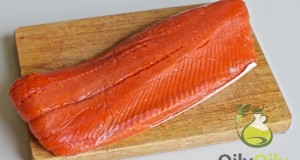
Photo credit: wikimedia
According to Wikipedia a boiling point of canola oil is the temperature at which the oil will turn into a vapor. Before the oil reaches its boiling point, it will begin to smoke. It is also called the ‘smoke point’. At this temperature fatty acids break down, emitting smoke. The flavor of the oil changes and the oil accumulates free radicals capable to cause cancer. Dietologists warn that the oil becomes inedible when it is heated over its smoke point. So it is a smoke point of oil that is necessary to know.
Boiling point of canola oil
Canola oil is extracted from the seeds of canola plant. It is vegetable oil, and it is always refined. The boiling point of canola oil is not important as your oil’s temperature should never exceed the smoke point. It is even dangerous when the oil reaches the boiling point and it bubbles. You should always remove it from heat. The smoke point of canola oil is 400 degrees Fahrenheit as Wikipedia states. It is considered as a medium-high smoke point so canola oil is ideal for deep-frying, baking, oven-cooking and so on. The temperature needed for deep-frying is 375 degrees F, lower than the smoke point of canola oil. In comparison, the smoke point of corn oil is 450 degree F. Keep in mind that it is not recommended to use any oil twice or three times because when you use the oil for cooking its smoke point reduces.
SEE ALSO: Cooking with Macadamia Nut Oil: Smoke Point and Safety
High oleic canola oil
There is another type of canola oil available now. High oleic canola oil has a higher percent of oleic omega-9 acid and lower in omega-3 fats than conventional canola oil. This type of oil is made especially for frying at high temperatures as its smoke point is higher and equals to 450°F. Read more how to fry with canola oil. High oleic canola oil is used for commercial food preparation.
RELATED: Pros and Cons of Canola Oil vs Soybean Oil
Comparison to other oils
If we compare canola oil with other oils we can see that the smoke point of the majority of refined vegetable oils is comparatively high. So canola oil and other vegetable oils may substitute each other for cooking. The advantage of canola oil over the above-mentioned vegetable oils is that it is high in healthier monounsaturated fatty acids and contains omega-3 essential fats. Olive oil also has such a beneficial fat profile. The smoke point of it, however, especially of its extra-virgin variety, is considerably lower and such olive oil doesn’t fit for frying. Flaxseed oil is high in omega-3 fatty acids, but its smoke point is so low that the oil can be used only for salad dressings and sauces. We see that canola oil is one of the best oils for cooking.
 Oilypedia.com – Benefits And Uses Of Supplemental and Essential Oils
Oilypedia.com – Benefits And Uses Of Supplemental and Essential Oils 


